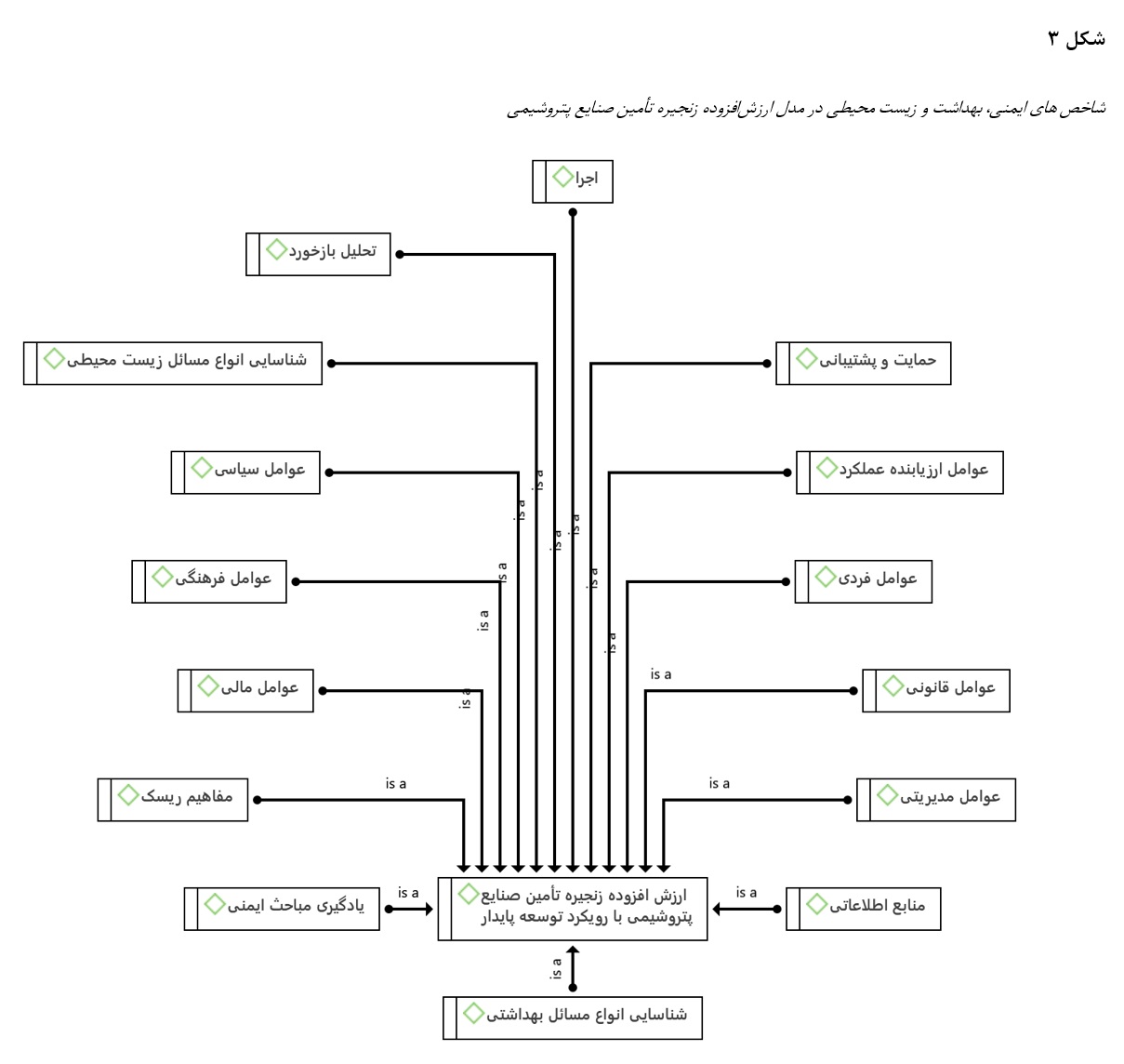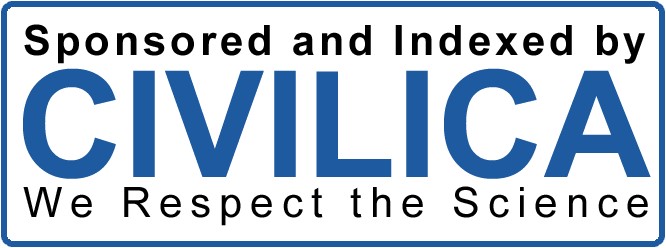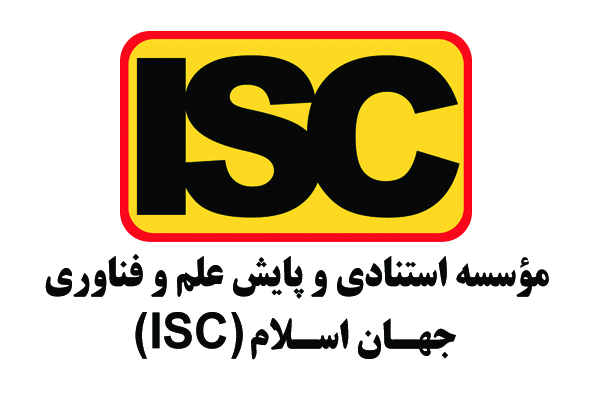کاربست تکنیک فراترکیب برای شناسایی شاخص های ایمنی، بهداشت و زیست محیطی در مدل ارزشافزوده زنجیره تأمین صنایع پتروشیمی
کلمات کلیدی:
ایمنی, بهداشت و محیطزیست, زنجیره ارزش, زنجیره تأمین صنایع پتروشیمیچکیده
هدف تحقیق کاربست تکنیک فراترکیب برای شناسایی شاخصهای ایمنی، بهداشت و زیست محیطی در مدل ارزشافزوده زنجیره تأمین صنایع پتروشیمی است. در صنایع پتروشیمی، ایمنی، بهداشت و زیست محیطی از اهمیت بسیاری برخوردارند. شاخصهای ایمنی مانند نرخ تصادفات کاری، آموزشهای ایمنی، و استفاده از تجهیزات محافظتی میتوانند نشاندهندهی پایداری عملیاتی در صنعت پتروشیمی باشند. محقق با بهکارگیری رویکرد مرور نظاممند و فراترکیب، به تحلیل نتایج و یافتههای محققین قبلی دستزده و با انجام گامهای 7 گانه روش ساندلوسکی و باروسو، به شناسایی عوامل مؤثر پرداخته است. از بین 556 مقاله، 55 مقاله بر اساس روش CASP انتخاب شد همچنین روایی تحلیل با مقدار ضریب کاپا 711/0 تائید گردید. در این زمینه بهمنظور سنجش پایایی و کنترل کیفیت، از روش رونوشت استفاده گردید که مقدار آن برای شاخصهای شناساییشده در سطح توافق عالی شناسایی شد. نتایج حاصل از تحلیل دادههای گرداوری شده در نرمافزار MAXQDA منتج به شناسایی 84 کد اولیه در 16 مقوله شد. 16 معیار عبارتاند عوامل سیاسی، عوامل فرهنگی، عوامل قانونی، عوامل مالی، عوامل فردی، عوامل مدیریتی، منابع اطلاعاتی، اجرا، بازنگری، تحلیل بازخورد، عوامل ارزیابنده عملکرد، مفاهیم ریسک، شناسایی انواع مسائل زیستمحیطی، شناسایی انواع مسائل بهداشتی، یادگیری مباحث ایمنی و ارزشافزوده زنجیره تأمین صنایع پتروشیمی با رویکرد توسعه پایدار. در مدل ارزشافزوده زنجیره تأمین صنایع پتروشیمی، شاخصهای ایمنی، بهداشت و زیست محیطی از اهمیت بسیاری برخوردارند. ایمنی در این صنایع اساسی است؛ زیرا عدم رعایت موازین ایمنی میتواند منجر به حوادث جدی، از جمله آسیبهای فردی و محیطی شود. در نتیجه، رعایت استانداردها و آموزشهای ایمنی به کارکنان و توسعه فناوریهای ایمنی میتواند بهبود چشمگیری در این صنعت به وجود آورد. همچنین، بهداشت کارکنان و حفظ سلامتی آنها یکی دیگر از اولویتهای این زنجیره تأمین است. ایجاد محیط کاری سالم و ارائه خدمات بهداشتی مناسب به کارگران میتواند به عنوان عاملی مهم در افزایش بهرهوری و کاهش نرخ آسیبهای ناشی از شرایط کاری نقش آفرین باشد.
دانلودها
مراجع
Abdel-Basset, M., & Mohamed, R. (2020). A novel plithogenic TOPSIS- CRITIC model for sustainable supply chain
risk management. Journal of Cleaner Production, 247, 119586. https://doi.org/10.1016/j.jclepro.2019.119586
Abdideh, M., & Dastyaft, F. (2022). Stress field analysis and its effect on selection of optimal well trajectory in directional
drilling (case study: southwest of Iran). Journal of Petroleum Exploration and Production Technology, 12(3), 835-
https://doi.org/10.1007/s13202-021-01337-5
Al-Qubaisi, S. S., & Ajmal, M. (2018). Determinants of operational efficiency in the oil and gas sector. Benchmarking:
An International Journal, 25(9), 3357-3385. https://doi.org/10.1108/BIJ-04-2017-0079
Alamroshan, F., La’li, M., & Yahyaei, M. (2022). The green-agile supplier selection problem for the medical devices: a
hybrid fuzzy decision-making approach. Environmental Science and Pollution Research, 29(5), 6793-6811.
https://doi.org/10.1007/s11356-021-14690-z
Bakhtiari, H., Amanipoor, H., & Battaleb-Looie, S. (2024). Analysis of heavy metal accumulation and environmental
indicators in fluids and drilling cuttings. Journal of Petroleum Exploration and Production Technology, 14(1), 41-
https://doi.org/10.1007/s13202-023-01690-7
Barzegar, R., Moghaddam, A. A., Tziritis, E., Fakhri, M. S., & Soltani, S. (2017). Identification of hydrogeochemical
processes and pollution sources of groundwater resources in the Marand plain, northwest of Iran. Environmental
Earth Sciences, 76(7), 297. https://doi.org/10.1007/s12665-017-6612-y
Bastas, A., & Liyanage, K. (2018). Sustainable supply chain quality management: A systematic review. Journal of
Cleaner Production, 181, 726-744. https://doi.org/10.1016/j.jclepro.2018.01.110
Baumgartner, R. J. (2014). Managing Corporate Sustainability and CSR: A Conceptual Framework Combining Values,
Strategies and Instruments Contributing to Sustainable Development. Corporate Social Responsibility and
Environmental Management, 21(5), 258-271. https://doi.org/10.1002/csr.1336
Bayat, A., Rahbar, F., Vatani, A., & Razavi, S. A. (2022). An Analysis of the Value Chains of the Petrochemical Industry
With a Focus on the New Approach of Petro-Refinery. Petroleum Business Review, 6(4), 115-132.
https://pbr.put.ac.ir/article_166828.html
Bazan, E., Jaber, M. Y., & Zanoni, S. (2017). Carbon emissions and energy effects on a two-level manufacturer-retailer
closed-loop supply chain model with remanufacturing subject to different coordination mechanisms. International
Journal of Production Economics, 183, 394-408. https://doi.org/10.1016/j.ijpe.2016.07.009
Chang, M.-H., Liou, J. J. H., & Lo, H.-W. (2019). A Hybrid MCDM Model for Evaluating Strategic Alliance Partners in
the Green Biopharmaceutical Industry. Sustainability, 11(15), 4065. https://www.mdpi.com/2071-1050/11/15/4065
Choudhary, N. A., Singh, S., Schoenherr, T., & Ramkumar, M. (2023). Risk assessment in supply chains: a state-of-theart review of methodologies and their applications. Annals of Operations Research, 322(2), 565-607.
https://doi.org/10.1007/s10479-022-04700-9
Cordova, M., & Coronado, F. (2021). Supply Chain Innovation and Sustainability Frontiers: A Balanced Scorecard
Perspective. In S. H. Park, M. A. Gonzalez-Perez, & D. E. Floriani (Eds.), The Palgrave Handbook of Corporate
Sustainability in the Digital Era (pp. 479-501). Springer International Publishing. https://doi.org/10.1007/978-3-
-42412-1_24
Darom, N. A., & Hishamuddin, H. (2023). Impacts of Resilience Practices on Supply Chain Sustainability. In S. K. Paul,
R. Agarwal, R. A. Sarker, & T. Rahman (Eds.), Supply Chain Risk and Disruption Management: Latest Tools,
Techniques and Management Approaches (pp. 231-244). Springer Nature Singapore. https://doi.org/10.1007/978-
-99-2629-9_12
De, M., & Giri, B. C. (2020). Modelling a closed-loop supply chain with a heterogeneous fleet under carbon emission
reduction policy. Transportation Research Part E: Logistics and Transportation Review, 133, 101813.
https://doi.org/10.1016/j.tre.2019.11.007
Duncan, J. M. A., Boruff, B., Saunders, A., Sun, Q., Hurley, J., & Amati, M. (2019). Turning down the heat: An enhanced
understanding of the relationship between urban vegetation and surface temperature at the city scale. Science of The
Total Environment, 656, 118-128. https://doi.org/10.1016/j.scitotenv.2018.11.223
El-Sheikh, L., & Kovačič Lukman, R. (2022). Developing a Framework for Closed-Loop Supply Chain and Its Impact
on Sustainability in the Petrochemicals Industry. Sustainability, 14(6), 3265. https://www.mdpi.com/2071-
/14/6/3265
Fatimah, Y. A., Govindan, K., Murniningsih, R., & Setiawan, A. (2020). Industry 4.0 based sustainable circular economy
approach for smart waste management system to achieve sustainable development goals: A case study of Indonesia.
Journal of Cleaner Production, 269, 122263. https://doi.org/10.1016/j.jclepro.2020.122263
Feng, Y., Wang, X., & Liang, Z. (2021). How does environmental information disclosure affect economic development
and haze pollution in Chinese cities? The mediating role of green technology innovation. Science of The Total
Environment, 775, 145811. https://doi.org/10.1016/j.scitotenv.2021.145811
Fernández-González, R., Puime-Guillén, F., & Vila-Biglieri, J. E. (2023). Environmental strategy and the petroleum
industry: a sustainability balanced scorecard approach. Journal of Petroleum Exploration and Production
Technology, 13(2), 763-774. https://doi.org/10.1007/s13202-022-01543-9
Geng, Z., Chen, Z., Meng, Q., & Han, Y. (2022). Novel Transformer Based on Gated Convolutional Neural Network for
Dynamic Soft Sensor Modeling of Industrial Processes. IEEE Transactions on Industrial Informatics, 18(3), 1521-
https://doi.org/10.1109/TII.2021.3086798
George, R. A., Siti-Nabiha, A. K., & Jalaludin, D. (2018). Sustainability institutionalisation: A mechanistic approach to
control change. Journal of Cleaner Production, 205, 36-48. https://doi.org/10.1016/j.jclepro.2018.09.095
George, R. A., Siti-Nabiha, A. K., Jalaludin, D., & Abdalla, Y. A. (2016). Barriers to and enablers of sustainability
integration in the performance management systems of an oil and gas company. Journal of Cleaner Production, 136,
-212. https://doi.org/10.1016/j.jclepro.2016.01.097
Ghalandari, M., Amirkhan, M., & Amoozad-Khalili, H. (2023). RETRACTED ARTICLE: A hybrid model for robust
design of sustainable closed-loop supply chain in lead-acid battery industry. Environmental Science and Pollution
Research, 30(1), 451-476. https://doi.org/10.1007/s11356-022-21840-4
Gong, Y., Liu, J., & Zhu, J. (2019). When to increase firms’ sustainable operations for efficiency? A data envelopment
analysis in the retailing industry. European Journal of Operational Research, 277(3), 1010-1026.
https://doi.org/10.1016/j.ejor.2019.03.019
González, N., Esplugas, R., Marquès, M., & Domingo, J. L. (2021). Concentrations of arsenic and vanadium in
environmental and biological samples collected in the neighborhood of petrochemical industries: A review of the
scientific literature. Science of The Total Environment, 771, 145149. https://doi.org/10.1016/j.scitotenv.2021.145149
Hailiang, Z., Khokhar, M., Islam, T., & Sharma, A. (2023). A model for green-resilient supplier selection: fuzzy best–
worst multi-criteria decision-making method and its applications. Environmental Science and Pollution Research,
(18), 54035-54058. https://doi.org/10.1007/s11356-023-25749-4
Han, F., Li, T., Sun, H., Zhong, H., Li, M., & Wang, Y. (2020). Investigation and assessment of pollution situation of
soil and groundwater in abandoned petrochemical sites. Chin J Soil Sci, 51(5), 1238-1245.
model_for_petrochemical_industry_in_China
He, L., Wu, Z., Xiang, W., Goh, M., Xu, Z., Song, W., Ming, X., & Wu, X. (2021). A novel Kano-QFD-DEMATEL
approach to optimise the risk resilience solution for sustainable supply chain. International Journal of Production
Research, 59(6), 1714-1735. https://doi.org/10.1080/00207543.2020.1724343
Jassem, S., Zakaria, Z., & Che Azmi, A. (2022). Sustainability balanced scorecard architecture and environmental
performance outcomes: a systematic review. International Journal of Productivity and Performance Management,
(5), 1728-1760. https://doi.org/10.1108/IJPPM-12-2019-0582
Jia, H., Gao, S., Duan, Y., Fu, Q., Che, X., Xu, H., Wang, Z., & Cheng, J. (2021). Investigation of health risk assessment
and odor pollution of volatile organic compounds from industrial activities in the Yangtze River Delta region, China.
Ecotoxicology and Environmental Safety, 208, 111474. https://doi.org/10.1016/j.ecoenv.2020.111474
Khan, S. A. R., Godil, D. I., Yu, Z., Abbas, F., & Shamim, M. A. (2022). Adoption of renewable energy sources, lowcarbon initiatives, and advanced logistical infrastructure—an step toward integrated global progress. Sustainable
Development, 30(1), 275-288. https://doi.org/10.1002/sd.2243
Lam, J. S. L., & Bai, X. (2016). A quality function deployment approach to improve maritime supply chain resilience.
Transportation Research Part E: Logistics and Transportation Review, 92, 16-27.
https://doi.org/10.1016/j.tre.2016.01.012
Li, H.-l., Zhu, X.-h., Chen, J.-y., & Jiang, F.-t. (2019). Environmental regulations, environmental governance efficiency
and the green transformation of China's iron and steel enterprises. Ecological Economics, 165, 106397.
https://doi.org/10.1016/j.ecolecon.2019.106397
Li, Y., Chiu, Y.-h., & Lin, T.-Y. (2019). Energy and Environmental Efficiency in Different Chinese Regions.
Sustainability, 11(4), 1216. https://www.mdpi.com/2071-1050/11/4/1216
Lin, S.-W., Lo, H.-W., & Gul, M. (2023). An assessment model for national sustainable development based on the hybrid
DEA and modified TOPSIS techniques. Complex & Intelligent Systems, 9(5), 5449-5466.
https://doi.org/10.1007/s40747-023-01034-2
Liu, H., Jin, F., Liu, Y., Ding, J., & Xu, X. (2011). Evaluation and optimization of petrochemical industrial spatial
organization in China. Acta Geographica Sinica, 66(10), 1332-1342.
https://www.geog.com.cn/EN/10.11821/xb201110004
Liu, J., Xi, Y., & Wang, J. (2023). Resilience strategies for sustainable supply chains under budget constraints in the post
COVID-19 era. Frontiers of Engineering Management, 10(1), 143-157. https://doi.org/10.1007/s42524-022-0236-y
Lo, H.-W., Liou, J. J. H., Wang, H.-S., & Tsai, Y.-S. (2018). An integrated model for solving problems in green supplier
selection and order allocation. Journal of Cleaner Production, 190, 339-352.
https://doi.org/10.1016/j.jclepro.2018.04.105
Nicoletti Junior, A., de Oliveira, M. C., & Helleno, A. L. (2018). Sustainability evaluation model for manufacturing
systems based on the correlation between triple bottom line dimensions and balanced scorecard perspectives. Journal
of Cleaner Production, 190, 84-93. https://doi.org/10.1016/j.jclepro.2018.04.136
Qiu, W., Li, S., Liu, Y., & Lu, K. (2019). Petrochemical and Industrial Sources of Volatile Organic Compounds Analyzed
via Regional Wind-Driven Network in Shanghai. Atmosphere, 10(12), 760. https://www.mdpi.com/2073-
/10/12/760
Rahuma, A., & Fethi, S. (2022). A new approach to evaluate environmental strategy: Empirical evidence from
international petroleum companies using the balanced scorecard model. Business Strategy and the Environment,
(7), 3152-3165. https://doi.org/10.1002/bse.3068
Rejowski, R., Shah, V., Fontenot, C. E., de Tarso, P., & Santos, V. E. N. (2009). Sustain Activities for Real-Time
Optimization Models of Ethylene Plants. In R. M. de Brito Alves, C. A. O. do Nascimento, & E. C. Biscaia (Eds.),
Computer Aided Chemical Engineering (Vol. 27, pp. 351-356). Elsevier. https://doi.org/10.1016/S1570-
(09)70279-2
Sangbor, M. A., Safi, M. R., Azar, A., & Rabieh, M. (2022). Identifying and Prioritizing Sustainable Supply Chain
Management Enablers in the Petrochemical Industry by Combined Approach of Meta-Synthesis Method and Graph
Theory and Matrix Approach (GTMA). https://www.sid.ir/paper/1033252/fa
Shafiee, M., Zare Mehrjerdi, Y., & Keshavarz, M. (2022). Integrating lean, resilient, and sustainable practices in supply
chain network: mathematical modelling and the AUGMECON2 approach. International Journal of Systems Science:
Operations & Logistics, 9(4), 451-471. https://doi.org/10.1080/23302674.2021.1921878
Shao, X.-F. (2013). Supply chain characteristics and disruption mitigation capability: an empirical investigation in China.
International Journal of Logistics Research and Applications, 16(4), 277-295.
https://doi.org/10.1080/13675567.2013.815695
Shen, T., Yu, H., & Wang, Y.-Z. (2021). Assessing the impacts of climate change and habitat suitability on the
distribution and quality of medicinal plant using multiple information integration: Take Gentiana rigescens as an
example. Ecological Indicators, 123, 107376. https://doi.org/10.1016/j.ecolind.2021.107376
Tavana, M., Sorooshian, S., & Mina, H. (2023). An integrated group fuzzy inference and best–worst method for supplier
selection in intelligent circular supply chains. Annals of Operations Research. https://doi.org/10.1007/s10479-023-
-0
Teng, Y., Zhou, Q., Miao, X., & Chen, Y. (2015). Assessment of soil organic contamination in a typical petrochemical
industry park in China. Environmental Science and Pollution Research, 22(13), 10227-10234.
https://doi.org/10.1007/s11356-015-4219-y
Tsai, F. M., Bui, T.-D., Tseng, M.-L., Ali, M. H., Lim, M. K., & Chiu, A. S. F. (2021). Sustainable supply chain
management trends in world regions: A data-driven analysis. Resources, Conservation and Recycling, 167, 105421.
https://doi.org/10.1016/j.resconrec.2021.105421
Udofia, E. E., Adejare, B. O., Olaore, G. O., & Udofia, E. E. (2021). Supply disruption in the wake of COVID-19 crisis
and organisational performance: mediated by organisational productivity and customer satisfaction. Journal of
Humanities and Applied Social Sciences, 3(5), 319-338. https://doi.org/10.1108/JHASS-08-2020-0138
Wang, M., Chen, H., & Lei, M. (2022). Identifying potentially contaminated areas with MaxEnt model for petrochemical
industry in China. Environmental Science and Pollution Research, 29(36), 54421-54431.
https://doi.org/10.1007/s11356-022-19697-8
Zhang, X., & Yousaf, H. M. A. U. (2020). Green supply chain coordination considering government intervention, green
investment, and customer green preferences in the petroleum industry. Journal of Cleaner Production, 246, 118984.

دانلود
چاپ شده
ارسال
بازنگری
پذیرش
شماره
نوع مقاله
مجوز
حق نشر 1403 تکنولوژی در کارآفرینی و مدیریت استراتژیک

این پروژه تحت مجوز بین المللی Creative Commons Attribution-NonCommercial 4.0 می باشد.










